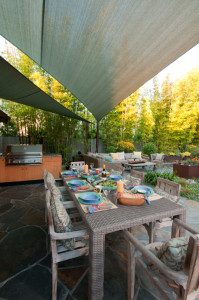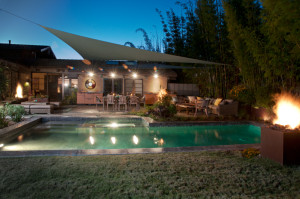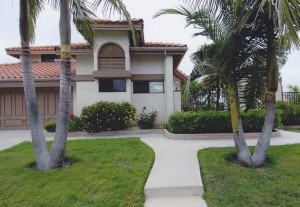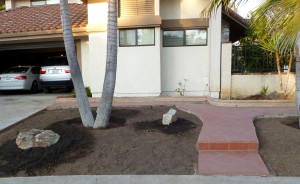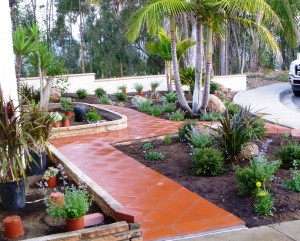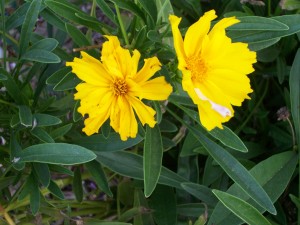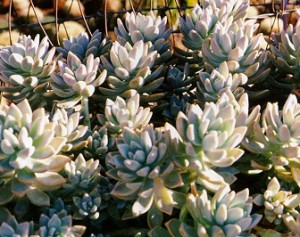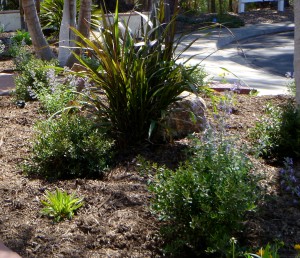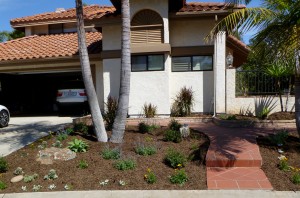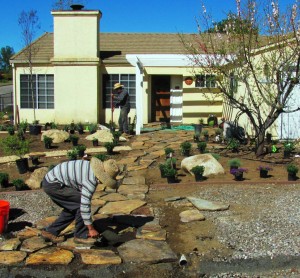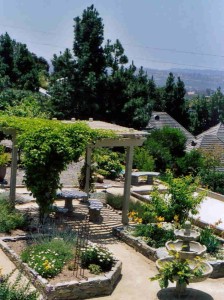January is a perfect time for winter clean up and fresh home landscape design ideas. This post shows you how to breathe new life into your garden.
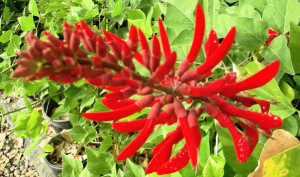 Coral Tree (Erythrina bidwillii) A Coral Tree in full bloom is a gorgeous sight, and seeing it you might have felt a stir of desire for such a punch of color in your garden? And did you realize that you haven’t enjoyed it much lately, that it is stale, and that much about it bothers you? But how do you breathe life into it?
Coral Tree (Erythrina bidwillii) A Coral Tree in full bloom is a gorgeous sight, and seeing it you might have felt a stir of desire for such a punch of color in your garden? And did you realize that you haven’t enjoyed it much lately, that it is stale, and that much about it bothers you? But how do you breathe life into it?
January, for us Southern Californios, is a perfect time for winter clean up and fresh landscape design ideas: Although this winter is warmer than usual, it is still a better season to plant than summer. So should you start your refresher with plants?
The Power of Structure
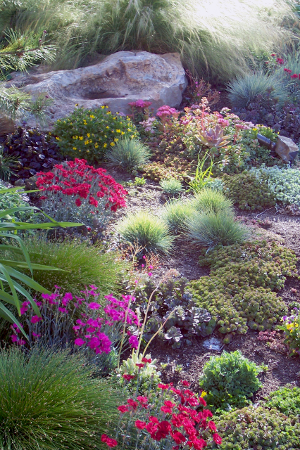
A beautiful plant scene is seductive, but without a structure is does not become a garden.
It’s easy to be seduced by the gorgeous plants at a specialty nursery or in a magazine, and many gardeners have the impression that introducing new exotics or the latest hybrid would be the solution to a satisfying outdoor living space. However, in my consultations at the Water Conservation Garden in El Cajon I meet many homeowners who, much more urgently than with plants, accents or atmosphere, need help with the basic “bones”. That is, with the structures that give shape and form to a garden: As the original meaning of the word ‘garden’ implies, it’s the ‘enclosure’ , the pathways and edgers, gates and transitions, pergolas and fences, patios and shelters that create the garden. Only when they can fulfill their functions of giving definition, protection and organization to the garden would I be ready to flesh it out with plants, accents, personal style.
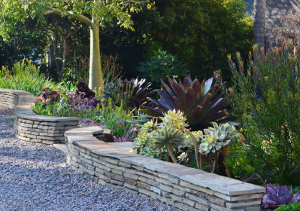 Thus, starting with the structure(s) can remedy the underlying defects or shortcomings of any landscape. But should you begin in the front yard, or rather the backyard?
Thus, starting with the structure(s) can remedy the underlying defects or shortcomings of any landscape. But should you begin in the front yard, or rather the backyard?
In practical life, it’s only you who can answer this questions: If your front yard is not inviting any longer and you get upset every time you come home, it’s time to invest here.
However, if you can accept the idea that the front yard isn’t perfect but it’s really your backyard that bothers you most because you don’t find the peace and comfort here that you dream of, it’s wiser and more satisfying to create that sanctuary first. From the enjoyment of that space it will be the easier to tolerate the imperfect front yard!
Elements to consider
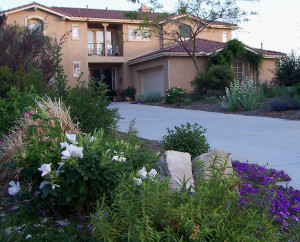 If it’s the front yard that needs refreshing, ask yourself: What’s there to invite a visitor to walk up to my front door? Could the trash cans be hidden behind their own enclosure? Are the irrigation valves out of sight? Is it safe for walking; are the steps even, the lighting sufficient, the path wide enough?
If it’s the front yard that needs refreshing, ask yourself: What’s there to invite a visitor to walk up to my front door? Could the trash cans be hidden behind their own enclosure? Are the irrigation valves out of sight? Is it safe for walking; are the steps even, the lighting sufficient, the path wide enough?
Is there a genuine walkway, or do your visitors walk up to your front door on your driveway? If so, now is the time to give your walkway the “weight” it deserves: To approach a front door on a driveway that’s just wide enough for the owner’s cars feels to me as though visitors aren’t really expected. Creating a walkway allows you to show off your landscape and to create a ‘discovery’ path makes the journey more memorable: Let the visitor get a feel for your personal touch and appreciate your love for details, by planting attractive plants, setting out yard art perhaps, or displaying an attractive container.
The garden underfoot
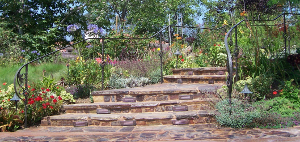
Here, a beautiful flagstone on concrete walkway is leads safely to the front door.
Don’t forget also to look at your pavement: Is it comfortable, safe and in harmony with the style of your house?
The options for the pavement materials are numerous: Prefabricated concrete pavers; porcelain or stone tile; brick or flagstones on concrete or placed directly on sand; DG or concrete…Even decking material (as in wood/timber or synthetic lumber) can work and give a beautifully warm and naturalistic touch to the landscape.
Flagstones “sand-set” with inter-planting lend naturalism to a landscape
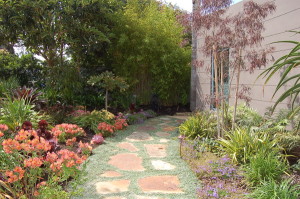 As a response perhaps to the stress of urban life and our isolation from nature, I get a lot of requests for flagstone and DG as pavement material because they are perceived as more naturalistic, and flagstone is very “in” these days. A flagstone path with green plants between the flat stones can look very attractive. The reality, unfortunately, is that these “inter-plantings” are rarely successful: As these plants need to be watered, this kind of pavement doesn’t contribute exactly to water savings, and it’s advisable to apply the irrigation at times when any puddles on the irregular surfaces of the stones can evaporate before the morning use.
As a response perhaps to the stress of urban life and our isolation from nature, I get a lot of requests for flagstone and DG as pavement material because they are perceived as more naturalistic, and flagstone is very “in” these days. A flagstone path with green plants between the flat stones can look very attractive. The reality, unfortunately, is that these “inter-plantings” are rarely successful: As these plants need to be watered, this kind of pavement doesn’t contribute exactly to water savings, and it’s advisable to apply the irrigation at times when any puddles on the irregular surfaces of the stones can evaporate before the morning use.
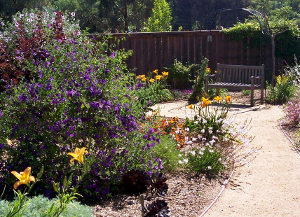
DG used in a naturalistic garden path fits well into a relaxed landscape
More of a nuisance are the weeds that invade these inter-spaces often and that are difficult to eliminate; most often they need to be pulled by hand. Leaving sand, DG (decomposed granite), or coarser gravel between the stones would be the easiest solutions.
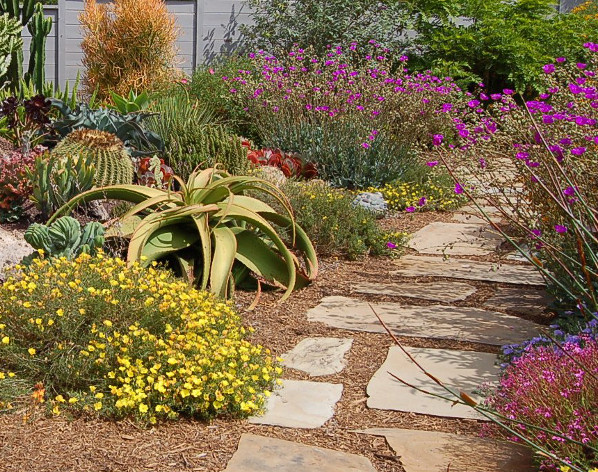
Flagstone as garden path is attractive material, with or without inter-planting
DG is made from weathered granite. In the landscape industry it is most often used in pavement as a naturalistic material that, if not “stabilized” by additives, is permeable. It is mixed with color and sold in several earth tones,and when compacted it is a material widely used in landscaping. Unfortunately, despite of the compaction and binding agents used in it, the surface grains sit loosely on top and therefore the DG should only be used on a flat area; in my opinion it’s not suitable for any ramped area as one could easily slip and fall.
As material used for a path leading to a front door I myself don’t use it much; I find it too ‘loose’ and relaxed for most front yards, and hesitate to recommend it when it is likely that feet and shoes carry the coarse sandy grains into the house.
Flagstone, firmly set in concrete in a walkway, is costly in comparison to interlocking pavers, or colored concrete, or laid “on grade” (on sand/without concrete base). With inter-spaces, and sand between the flags, it is not as foot-friendly and trip-safe as I would want it to be, in a space that’s accessible to the public.
Concrete pavers (“interlocking”) are a very popular paving material
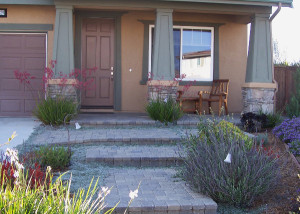 Interlocking (or segmental) pavers are much in demand these days because versatile and attractive. (Actually, pavers made from stone, concrete or brick have been in use for thousands of years.) The varying degrees of tumbling of the paving stones that define the texture, and the pattern and size define the character of the paved areas, and you can achieve effects from an elegant smooth pavement to a historic-looking ancient cobble stone effect.
Interlocking (or segmental) pavers are much in demand these days because versatile and attractive. (Actually, pavers made from stone, concrete or brick have been in use for thousands of years.) The varying degrees of tumbling of the paving stones that define the texture, and the pattern and size define the character of the paved areas, and you can achieve effects from an elegant smooth pavement to a historic-looking ancient cobble stone effect.
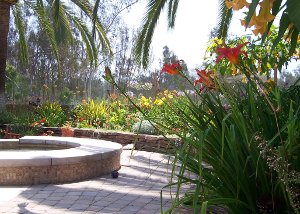 The pavers are easy to remove if necessary (for instance when you want to add a footing for a shade structure or other features later); cracking can never occur (as would be possible with concrete pavement).
The pavers are easy to remove if necessary (for instance when you want to add a footing for a shade structure or other features later); cracking can never occur (as would be possible with concrete pavement).
Colored concrete is also used; I find the sandy “sand finish” or “acid wash” on colored concrete very attractive and fitting into a contemporary as well as a classic look.
Whether colored acid-wash concrete, concrete pavers or cut stone pavers laid directly “on grade” (directly on native soil or sand), you’d benefit from the help from an experienced craftsman/mason.
Click here to read more about DIY Landscape Design …
